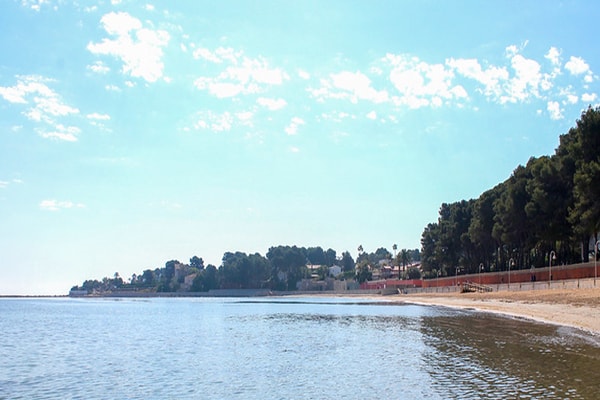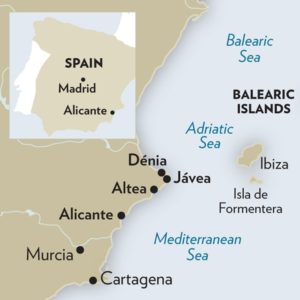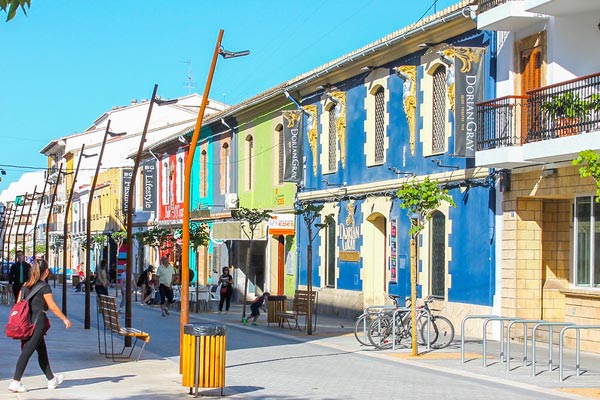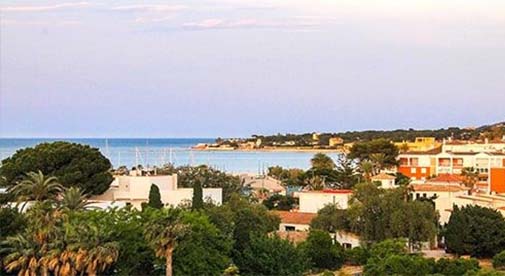Seeing New York City for the first time is as much a confirmation as an exploration. A lifetime of cop shows, romantic comedies, and music videos makes every brownstone fire department, yellow cab, or hot dog stand seem familiar. And, although less pronounced, something similar happened when I got to Dénia, on Spain’s Costa Blanca.
OK, that’s as far as the comparison goes. Dénia doesn’t have any skyscrapers, baseball fields, or Wall Street traders, but it does come with an aura of expectation. In the 13 years I lived in Spain, Dénia featured in countless conversations. The mention of its name was usually accompanied by a longing sigh and a wistful gaze into the middle distance.
Dénia is the vacation town that Spaniards spend the winter months longing for. It’s the place where they make those childhood memories—the ones where summer lasted half a lifetime and was spent barefoot, paddling in rockpools, and running across hot sand. High-powered Madrid CEOs and hedge-fund managers turn back into little kids when they hear the name “Dénia,” and launch into stories about the massive dorado they once caught from their uncle’s skiff or the time they climbed the castle’s walls. If Huck Finn had Jackson’s Island to escape to, for the well-to-do Spaniard, it’s this meandering little hill town on the Mediterranean coast.
From the imposing castle at its pinnacle, Dénia town spreads out, blanket-like, to the edge of the sea.
The Montgó massif towers to the south—a craggy escarpment of exposed limestone jutting into the sea. Montgó is today most important as a designated natural park, and the green lung that gives the surrounding region such remarkable air quality. That’s no exaggeration— just standing around taking deep breaths is a rewarding pastime in Dénia. Every lungful is a hearty dose of tangy sea air with just a hint of menthol freshness.
The mountain road which climbs Montgó to the clifftops at the Cabo San Antonio viewpoint twists through miles of forested uplands, where the vegetation noticeably changes with elevation. Palm trees at the base give way to olive groves, wild lavender, and rock rose blooms in the mid-section, then pine forest at the upper levels. It’s a geography lesson on microclimates within a five-mile drive.
Down on the flatlands around Dénia town, the remnants of multiple civilizations are visible, underlining the fact that this area—fronted by a deep harbor, sheltered by steep mountains, watered by constant freshwater streams, and blessed with year-round sunshine—was as well thought of by Iberians, Greeks, and Romans as it is by Spaniards today.

Spain has been slow to recover from the economic crisis of 2008. One knock-on effect of that is that the real estate market is highly competitive in places like Dénia, where luxurious second homes and vacation apartments—a financial burden to their current owners—are still coming up for sale with regularity.
Real estate agents are plentiful in town and are geared to an international clientele. There’s no difficulty finding one who speaks good English. Rent for a modern 800-square-foot, two-bedroom, one-bathroom apartment with outdoor terrace, community garden, and pool can be as low as $675 a month. A three-bedroom, two-bathroom, 1,800-square-foot house with sea views, garden, and terrace is on the market for a shade under $200,000.
What’s surprising, for such a privileged location, is how little known Dénia is outside of Spain. That’s largely because the industry of mass tourism on the Costa Blanca has mostly been focused elsewhere.
Valencia, some 60 miles north, is the commercial and cultural hub of the region. It’s there that you’ll find the international airport with flights to European cities, and where the standard attractions of any major city are available. Universities, hospitals, and big box stores cluster around Valencia’s major routes, while closer into the city center the more cultural amenities start— theaters, galleries, museums, and the like.
South from Dénia, about the same distance away as Valencia, is Alicante. It’s another city, smaller than Valencia, with a population around a third of a million (Valencia’s is almost 800,000). Since the 1970s, Alicante airport has been a conduit for the flow of tourists to the Costa Blanca on affordable package vacations. And while the purpose-developed resorts in the immediate vicinity of Alicante have, for decades, hosted droves of northern Europeans in search of sunshine, Dénia is just beyond the zone where that short-stay tourism is focused.
What’s more, there’s the beating heart of a regional market town in Dénia that is independent of the tourist trade. While the resorts to the south effectively close down from October to May, the year-round population of 40,000 is sufficient to keep things ticking over in Dénia, whatever the month. Certainly, it’s more crowded in July and August (when all those Madrid CEOs and hedge-fund managers are in town), but the bars, restaurants, market, banks, and supermarkets stay open throughout the year.
That makes Dénia a real prospect as a long-term retirement destination. And it’s a truly pretty place to live, too. The narrow streets of the old town are lined with bars and restaurants, each with rows of outdoor seating where it’s easy to while away an evening over dinner, watching the people out on their evening paseo under the blossoming jacaranda trees and towering date palms which punctuate the handsome 19th-century architecture.

The town is a gastronomic hub, where freshly caught seafood takes pride of place arrayed on top of piping-hot paella, or platefuls of the local specialty—a species of red shrimp which only thrives in the warm waters between Dénia and the Balearic Islands—are washed down with a cold glass of lightly sparkling white wine. Don’t expect either of these local delicacies to come cheap—they’re treats for special occasions. Paella is a traditional blow-out meal for Sunday lunch, and red shrimp are a seasonal (and highly prized) indulgence. Even so, you’ll be hard-pressed to spend more than $25 on a plateful of either, and that includes the wine.
Dining options in Dénia include the down-home family places that thrive all over Spain—tables in front (usually with a few gentlemen indulging in tapas, small bottles of beer, and animated rounds of the card game mus), with a dining area in a separate room behind the bar. These are a national treasure. When you find a good one, it’s some of the best small-scale, home-style cooking you’ll come across anywhere. Search for chalkboards outside bars announcing “Menú del Dia.” Three courses, usually with a choice of meat or fish for the main, often including a coffee, and always including simple but very palatable wine, runs from $10 to $15.
At the other end of the scale, the restaurants at the lower end of the old town, close to the marina, offer upscale international cuisine in stylish (and highly styled) restaurants. Quique Dacosta, on the seafront, boasts three Michelin stars. El Raset, and Peix y Brases are both Michelin-rated too, with their sights firmly set on Dacosta’s coveted ratings.
Fine food, eaten in comfortable surroundings, is a fundamental part of the culture in Dénia. Expats here take that seriously too. Every one of the expats I met in Dénia shared a meal with me, and each time, it was convivial, unhurried, and within sight of the sea. There’s more to the “Mediterranean diet” than the ingredients on the plate, and taking the time to prepare good food, relax, and chat around the table may be part of the reason Spaniards enjoy some of the longest lifespans in the world.

I certainly ate well when I visited Eric Trujillo and Amalia Maloney del Riego, who moved to Dénia from Denver, Colorado in June 2015. The plates of local charcuterie, cheeses, olives, and juicy, ripe fruit prepared for my visit were delectable.
I met them in their apartment on the south side of town, where the narrow alleys of the medieval quarter widen out into grand boulevards lined with handsome 21st-century condo buildings of around 10 to 12 floors high. Normally, the temptation would be to call this area the “new town,” except that right in front of their building are the newly exposed foundations of a Greco-Roman villa—a couple of thousand years old.
“Dénia is a series of layers,” Amalia says. “Every time they zone a new building area, there’s an archaeological dig to make sure there’s nothing important underneath. There nearly always is though, and the deeper they dig, the older it gets.” In fact, Dénia’s name is derived from the Roman goddess Diana. The Romans weren’t the first to settle here, but the name stuck.
Like many expats I met there, Eric and Amalia ended up in Dénia by chance. Eric, who works remotely in design and media, was offered a contract in Madrid some years ago. The job fell through, but not before he’d had time to explore some of Spain. Spain’s southern coast appealed initially. “It’s nice,” Eric says, “but it was a little too touristy for our taste.” The search continued, up to the east coast. “I have some friends in Valencia that I was visiting, and I was scoping the city out as a place to move to,” Eric continues.
Convivial, unhurried meals in sight of the sea.
A day trip to the beach at Dénia turned into a revelatory moment, and over the course of a couple more visits, Eric and Amalia realized that this could be the perfect place for them to live. “I love to sail,” Eric says, “although it’s been years since I’ve had the chance to do so. Now we’re living right next to a marina, I hope to take that up again.”
They walk me through their three-bedroom, three-bathroom duplex apartment, which is delightfully bright and detailed with the decorative touches you would expect from two people whose work involves design and artistry (Amalia is a website designer, travel blogger, and photographer). Every room has a sea view, and the largest of their terraces has space for a table, chairs, lounge area, and barbecue corner. The other three terraces are smaller, but still large enough for a couple of loungers to catch the morning sun.
“It’s great value here compared to the U.S. This all comes in at $1,000 a month in rent. Utilities are very affordable compared to the States, too,” Amalia says. “We downsized when we came, just bringing what we could fit into a couple of suitcases. We’re really happy with the light feeling of living like this, and our landlord is happy with having us as tenants, because we look after the place well and pay our rent on time.”
As the warm evening darkened to night, and the thyme-scented mountain air blew gently over the fine sand of Dénia’s beach, I couldn’t help but feel a pang of envy.

Get Your Free Spain Report Here:
Learn more about Spain and other countries in our free daily postcard e-letter. Simply enter your email address below and we'll also send you a FREE REPORT - Live the Good Life in Sunny, Affordable Spain.
This report covers real estate, retirement and more in Spain and is yours free when you sign up for our IL postcards below.
Related Articles
A Sea View Home for $1,140 a Month in Dénia, Spain
Spain Visa and Residency Information
Everthing You Need to Know About Retiring in Spain
Upcoming Conferences
The Only 2024 Fast Track Panama Conference
If your dream retirement involves stunning beaches… lush green mountains… a warm climate with no hurricanes… first-rate healthcare… incredible value for money (a couple can live well on $2,200 a month)… and the World’s #1 Retiree Discount Program…
Join our Panama experts and expats in February and discover why Panama could be your perfect paradise.
REGISTER NOW, SEATS LIMITED: EARLY BIRD DISCOUNT HERE


.png)